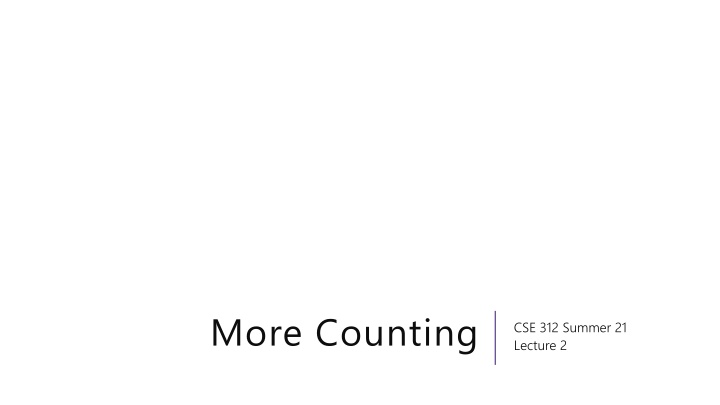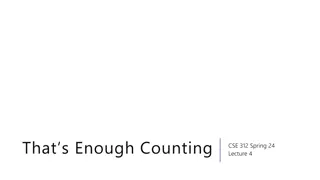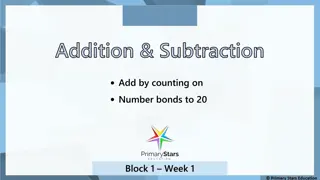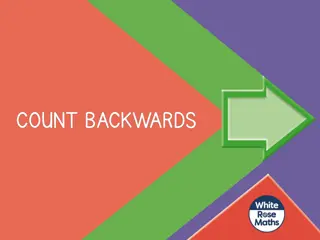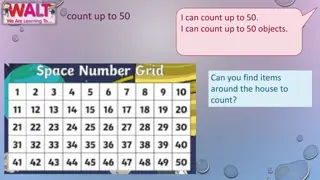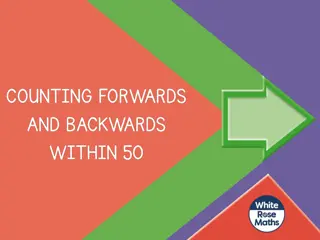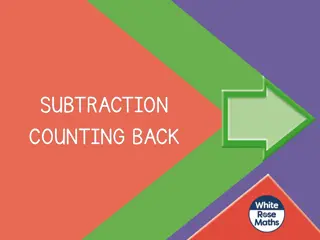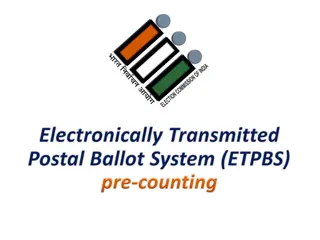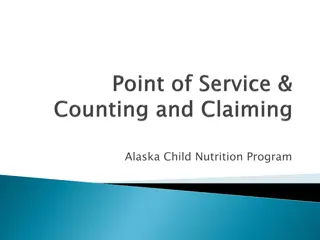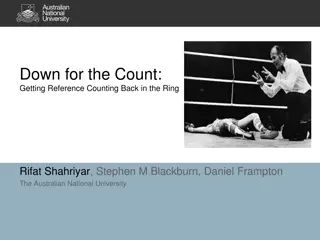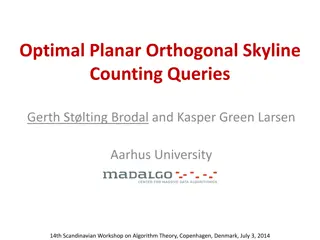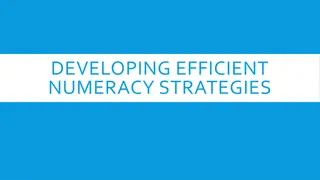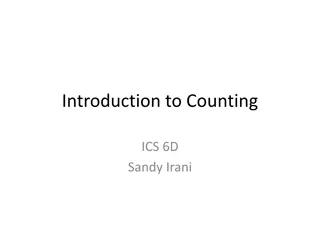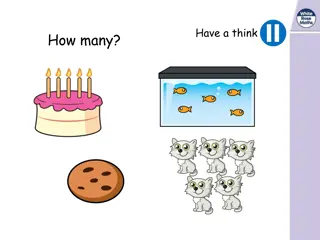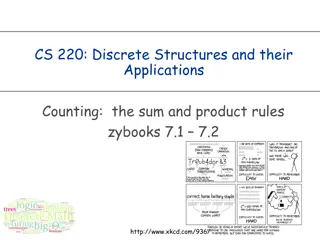More Counting
Announcements for CSE 312 Summer Lecture 2 with topics on permutations, combinations, and the binomial theorem. Explore sequential processes, factorial concepts, and dense questions in combinatorics. Understand the importance of order, distinct elements, and the universe of allowed elements in counting exercises.
Uploaded on Feb 18, 2025 | 3 Views
Download Presentation

Please find below an Image/Link to download the presentation.
The content on the website is provided AS IS for your information and personal use only. It may not be sold, licensed, or shared on other websites without obtaining consent from the author.If you encounter any issues during the download, it is possible that the publisher has removed the file from their server.
You are allowed to download the files provided on this website for personal or commercial use, subject to the condition that they are used lawfully. All files are the property of their respective owners.
The content on the website is provided AS IS for your information and personal use only. It may not be sold, licensed, or shared on other websites without obtaining consent from the author.
E N D
Presentation Transcript
More Counting CSE 312 Summer 21 Lecture 2
Announcements Office hours for this week: Kushal: Friday 1 pm 2pm Student Information for Office Hours https://forms.gle/S5eDFe5bgipgh2MC8 Just one question your current time zone Syllabus should be up by tonight
Where Are We? Last Lecture: Sum and Product Rules Sequential Process Representation is important! Today: Permutations and Combinations Complementary Counting Binomial Theorem
More sequential process practice How many length 3 sequences are there consisting of distinct elements of 1,2,3 ?
Pause Questions in combinatorics are probability are often dense. A single word can totally change the question. Does order matter? Are repeats allowed? What makes two things count the same or count as different ?
More sequential process practice Let s look for some keywords in the question How many length 3 sequences sequences are there consisting of distinct of 1,2,3 ? distinct elements Sequence Sequence implies that order matters 1,2,3 and (3,1,2) are different Distinct Distinct implies that we cannot repeat elements (1,2,1) does not count {1,2,3} is our universe our set of allowed elements
More sequential process practice How many length 3 sequences of 1,2,3 ? sequences are there consisting of distinct distinct elements Step 1: 3 options for the first element Step 2: 2 (remaining) options for the second element Step 3: 1 (remaining) option for the third element 3 2 1 = 6
Factorial This formula shows up a lot! The number of ways to permute (i.e., reorder or list without repeats ) ? elements is ? factorial ? factorial ?! = ? ? ? ? ? ? We only define ?! for natural numbers ?. As a convention, we define: 0! = 1.
Distinct Letters How many strings of length 5 are there over the alphabet {?,?,?, ,?} where each string does not repeat a letter? E.g., SWING SWING is allowed but SALSA SALSA is not
Distinct Letters How many strings of length 5 are there over the alphabet {?,?,?, ,?} where each string does not repeat a letter? E.g., SWING SWING is allowed but SALSA SALSA is not Step 1: 26 options for the first letter Step 2: 25 options for the second letter Step 5: 22 options for the fifth letter 26 25 24 23 22
In General ?-permutation The number of ?-element sequences of distinct symbols from a universe of ? symbols is: ?! ? ?,? = ? ? ? ? ? + ? = ? ? ! Said out loud as P n k or n permute k or n pick k Alternative notation: ?? ? or ??? Edge cases: ? ?,? = ?!,? ?,0 = 1,? ?,? is undefined for ? < 0 or ? > ?
Change it slightly How many subsets Remember for sets we don t count repeats so that constraint still stays But for sets order does not matter subsets of size 5 are there of ?,?, ,? ? {?,?,?,?,?} is the same as ?,?,?,?,?even though SWING and WINGS are different strings.
Count two ways Let s artificially introduce a requirement that we are supposed to have an ordered list. Then the total is ?(26,5) as we have seen before. How else could we get an ordered list? With a sequential process: Step 1: Choose a subset Step 2: Put the subset in order These better give the same number, so: 26! 26 5 != ? 5!
Count two ways Let s artificially introduce a requirement that we are supposed to have an ordered list. Then the total is ?(26,5) as we have seen before. How else could we get an ordered list? With a sequential process: Step 1: Choose a subset Step 2: Put the subset in order These better give the same number, so: 26! 26 5 != ? 5! So, the number of size 5 subsets of the size 26 set is: 26! 26 5 !5!
Number of subsets ?-combination The number of ?-element subsets from a set of ? symbols is: ? ?,? =? ?,? ?! ?! = ?! ? ? ! Said out loud n choose k (or sometimes: n combination k ) Notations: ??? or ? Edge cases: ? 0= 1, ? or ?(?,?)all mean number of size ? subsets of a size ? set ? ?= 1, ? ? is undefined for ? < 0 or ? > ?
Takeaway The second way of counting hints at a generally useful trick: Pretend that order does matter, then divide by the number of orderings of the parts where order does not matter. For example, here is another way to get the formula for combinations: You have ? elements. Put them in order, take ? as your set. ?! orderings overall. We have overcounted because: - Among the first ?, order does not matter. Divide by ?! - Among the last ? ? , order does not matter. Divide by ? ? ! ?! ? ? !?!
Path Counting We are in the lower left corner and want to get to the upper right corner. Only moves allowed are up and right. How many paths lead to our destination? A. 28 B. ?(8,4) C. 4 D. Something else 8 Fill out the Poll Everywhere for Kushal to adjust his explanation Go to pollev.com/cse312su21
Path Counting We are in the lower left corner and want to get to the upper right corner. Only moves allowed are up and right. How many paths lead to our destination? Idea 1: We are going to take 8 steps Choose which SET of 4 of the steps will be up (the others will be right).
Path Counting We are in the lower left corner and want to get to the upper right corner. Only moves allowed are up and right. How many paths lead to our destination? Idea 1: We are going to take 8 steps Choose which SET of 4 of the steps will be up (the others will be right). E.g. {1,2,7,8}
Path Counting We are in the lower left corner and want to get to the upper right corner. Only moves allowed are up and right. How many paths lead to our destination? Idea 1: We are going to take 8 steps Choose which SET of 4 of the steps will be up (the others will be right). E.g. {1,2,7,8} Hence, how many size 4 subsets are there?
Path Counting We are in the lower left corner and want to get to the upper right corner. Only moves allowed are up and right. How many paths lead to our destination? Idea 1: We are going to take 8 steps Choose which SET of 4 of the steps will be up (the others will be right). E.g. {1,2,7,8} Hence, how many size 4 subsets are there? The answer: 8 4
Path Counting How do we know we are done counting? Why did we not count the steps to the right? We have chosen the 4 steps up. Of the remaining 4 steps, we will choose 4 of them to be to the right. The number of ways we choose steps to the right: 4 So, multiplying by this does not change anything. 4= 1 ??? We are done counting when given the choices of our sequential process, we know exactly which path we take. And given a path, we know exactly the choices of our sequential process.
Path Counting We are in the lower left corner and want to get to the upper right corner. Only moves allowed are up and right. How many paths lead to our destination? Idea 2: Introduce artificial ordering Order ? ? ? ? ? ? ? ?8!
Path Counting We are in the lower left corner and want to get to the upper right corner. Only moves allowed are up and right. How many paths lead to our destination? Idea 2: Introduce artificial ordering Order ? ? ? ? ? ? ? ?8! Remove the overcounting The 4 are the really the same, divide by 4! The 4 are the really the same, divide by 4! 8! 4! 4!= 4 8 Total:
Overcounting How many anagrams are there of SEATTLE? Anagram a rearrangement of letters
Overcounting How many anagrams are there of SEATTLE? Anagram a rearrangement of letters It is not 7! 7! counts SEATTLE and SEATTLE (where the Es are switched) as different words.
Overcounting How many anagrams are there of SEATTLE? Pretend that the order of the Es and Ts relative to each other matter (SEATTLE and SEATTLE are indeed different) How many arrangements of SEATTLE? 7! Now, returning to the question where both Es (and Ts) are the same How have we overcounted? Es relative to each other and Ts relative to each other. Overcounts: 2! 2! 7! Final Answer: 2! 2!
One More Counting Technique Complementary Counting Complementary Counting Count the complement of the set you re interested in. How many length 5 strings over ?,?,?, ,? are there with at least Let ?be the set of strings we re interested in, ? be all length 5 strings ? will therefore be the set of strings that have no ? in them. ? = ? ? = ? ? = 265 255 at least 1?
Takeaways Formulas for factorial, permutations, and combinations. A useful trick for counting is to pretend that order matters, then account for the overcounting at the end dividing the repetitions. When you are trying to prove facts about counting (more in the appendix), try to have each side of the equation count the same thing. It will be much more intuitive and fun than churning through complex algebra.
Binomial Theorem In high school you probably memorized ? + ?2= ?2+ 2?? + ?2 And ? + ?3= ?3+ 3?2? + 3??2+ ?3 The Binomial Theorem gives us the equation for every power ?: The Binomial Theorem ? ? ? ? + ??= ???? ? ?=0
Some intuition The Binomial Theorem ? ? ? ? + ??= ???? ? ?=0 Intuition: Every monomial on the right-hand-side has either ? or ? from each of the terms on the left. How many copies of ???? ? do you get? Well how many ways are there to choose ?? s and ? ? ? s? ? Formal proof? Induction! ?.
So What? Well if you saw it before, now you have a better understanding now of why it s true. There are also a few cute applications of the binomial theorem to proving other theorems (usually by plugging in numbers for ? and ?) For example, set ? = 1 and ? = 1 then 2?= 1 + 1?= ?=0 i.e. if you sum up binomial coefficients, you get 2?. Exercise: reprove this equation (directly) with a combinatorial proof (where have we seen 2? recently?) ? ?. ? ?1?1? ?= ?=0 ? ?
Some Facts about combinations Symmetry of combinations: ? ? ?= ? ? Pascal s Rule: ? ? 1 ? 1+ ? 1 ? ?=
Two Proofs of Symmetry Proof 1: By algebra ?! ? ?= Definition of Combination ?! ? ? ! ?! = Algebra (commutativity of multiplication) ? ? !?! = ? Definition of Combination ? ?
Two Proofs of Symmetry Wasn t that a great proof. Airtight. No disputing it. Got to say commutativity of multiplication. But do you know why? Can you feel why it s true?
Two Proofs of Symmetry Suppose you have ? people, and need to choose ? people to be on your team. We will count the number of possible teams two different ways. Way 1 Way 1: We choose the ?people to be on the team. Since order doesn t matter (you re on the team or not), there are ? Way 2 Way 2: We choose the ? ? people to NOT be on the team. Everyone else is on it. Since order again doesn t matter, there are ways to choose the team. Since we re counting the same thing, the numbers must be equal. So ? ?= ? possible teams. ? ? possible ? ? ?. ?
Pascals Rule: ? ?= ? 1 ? 1+ ? 1 ?
Pascals Rule: ? ?= ? 1 ? 1+ ? 1 ? You and ? 1 other people are trying out for a ? person team. How many possible teams are there?
Pascals Rule: ? ?= ? 1 ? 1+ ? 1 ? You and ? 1 other people are trying out for a ? person team. How many possible teams are there? Way 1 Way 1: There are ?people total, of which we re choosing ?(and since it s a team order doesn t matter) ? Way 2 Way 2: There are two types of teams. Those for which you make the team, and those for which you don t. If you do make the team, then ? 1 of the other ? 1 also make it. If you don t make the team, ? of the other ? 1 also make it. Overall, by sum rule, ? 1 ? 1+ ? Since we re computing the same number two different ways, they must be equal. So: ? ?= ? ?. . ? 1 ? 1 ? 1+ ? 1
Books, revisited Remember the books problem from lecture 1? Books 1,2,3,4,5 need to be assigned to Alice, Claris, and Pascal (each book to exactly one person). Now that we know combinations, try a sequential process approach. It won t be as nice as the change of perspective, but we can make it work. Break into cases based on how many books Alice gets, use the sum rule to combine.
Books, revisited Step 1: give Alice gets 0 books (1 way to do this) Step 2: give Claris a subset of the remaining books 25 ways. Step 3: give Pascal the remaining books (no choice 1 way) + Step 1: give Alice 1 book (5 Step 2: give Claris a subset of the 4 remaining books 24 ways. Step 3: give Pascal the remaining books (no choice 1 way) 1 ways to do this) +
Books, revisited Add all the options together 5 1 24 1 + 5 2 23 1 + 5 3 22 1 + 5 4 21 1 + 5 5 20 1 1 25 1 + If you plug and chug, you ll get the number we got last time. It took quite a bit of work, but we got there!
